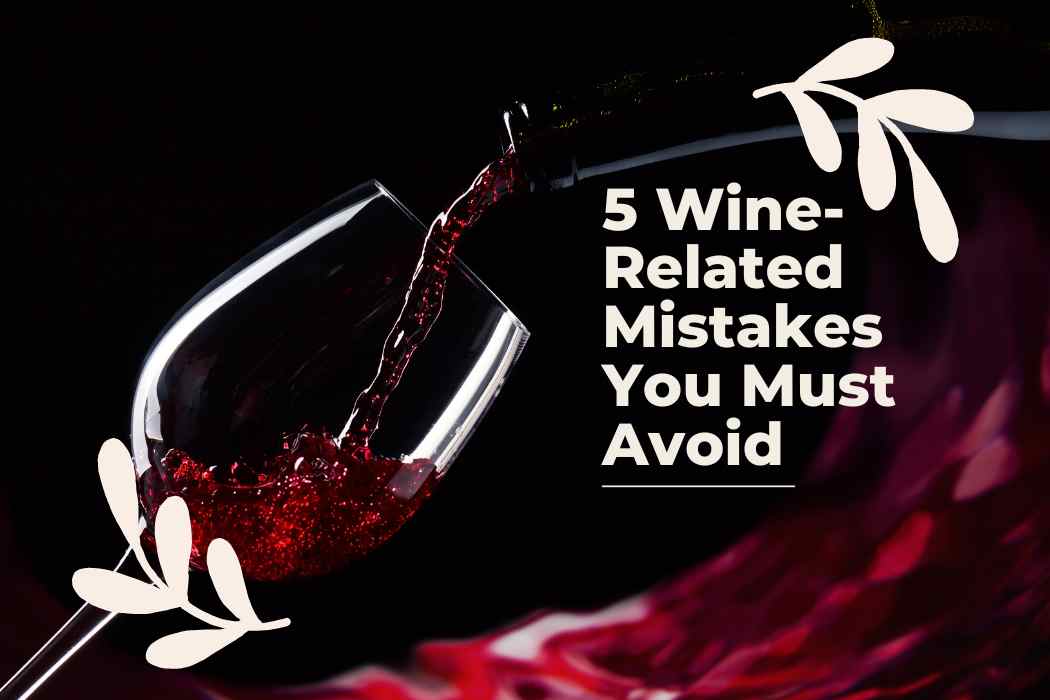Sometimes, even seasoned wine drinkers occasionally commit frequent mistakes when enjoying their favorite wine. From serving temperatures to pairing faux pas, we’ve compiled a list of five wine-related mistakes you must avoid. So, sit back, pour yourself a glass, and let’s dive into how to enjoy your wine to its fullest potential without committing any of these blunders!
- Drinking Wine Too Warm or Too Cold
When it comes to wine, temperature matters. Drinking wine at the wrong temperature can completely alter its taste and aroma profile, making it less enjoyable.
Drinking wine that is too warm can intensify the alcohol content and mute the subtler flavors of the wine. However, sipping cold wine could make it seem uninteresting and dull. So, how do you decide what is right?
White wines should generally be served cold, between 45°F and 55°F, while red wines should typically be served slightly warmer than room temperature (between 60°F and 68°F). The ideal serving temperature for sparkling wines is 40–50°F.
Maintaining the correct temperature for your wine both during serving and throughout the meal is vital. After all, you wouldn’t want your perfectly chilled wine to lose its refreshing coolness and become lukewarm before dinner!
So, whether playing the gracious host or sharing a quiet evening with friends, ensure your prized elixir is served at its best temperature. Plus, you will need the right tools to serve you wine, so head over to https://kosmonaut.co to get your hands on some of the best wine equipment.
2. Sipping an Old, Opened Bottle
Have you ever been drinking wine sitting in your refrigerator for weeks? Finishing an old, opened bottle may be tempting, but you should be aware that wine quality and flavor can change over time. The wine oxidizes when exposed to air, which can modify the flavor and aroma. Older bottles experience this process much more quickly because they have already experienced some oxidation during their aging phase. Invest in a wine preservation system, or simply re-cork the bottle tightly and store it in the refrigerator.
If you want to save leftover wine for more than a few days, consider freezing them into ice cubes for later use in cooking or cocktails. Various preservation methods can be employed to extend an opened bottle’s lifespan. From vacuum sealers that remove excess oxygen to inert gas systems that create a protective barrier, these tools can help maintain the wine’s freshness for longer. Remember, always trust your palate when tasting an old bottle of wine. If it tastes like vinegar or has lost its original flavors and aromas, it’s best not to risk consuming it.
3. Storing Wine Incorrectly
Storing wine not correctly can ruin the taste and aroma of your favorite bottle. Start by finding it a cool, dim home, away from the harsh glare of direct sunlight, which can tarnish its quality. Secondly, store bottles on their side or at an angle to keep corks moist and prevents air from entering the bottle. Additionally, avoid storing bottles above or next to appliances that produce heat, such as ovens or refrigerators.
Humidity levels are also crucial when storing wine – too little humidity causes corks to dry out, while excess humidity leads to mold growth on labels and cardboard packaging. Aim for a relative humidity level of about 70% in your storage area. Furthermore, improper positioning of wine bottles can result in a loss of flavor and aroma. Remember, horizontal storage helps keep the cork moist, preventing unwanted oxygen from seeping in. By following these simple guidelines for proper wine storage, you’ll be able to maintain the integrity of your favorite bottles and enjoy them at their best!
4. Pouring Too Much in The Glass
One of wine lovers’ typical mistakes is pouring too much wine into their glass. Although filling your glass to the top may seem like a good idea, doing so will make wine less enjoyable.
Firstly, pouring too much wine into your glass leaves little room for swirling and sniffing – two essential steps in properly enjoying and evaluating a wine. Without these steps, you may miss out on important aromas and flavors. Secondly, over-pouring can also negatively affect the temperature of the wine. If there’s too much liquid in the glass, it will warm up faster from holding onto excess heat from your hand. Drinking too much wine at once defeats its purpose as a beverage for savoring and enjoyment rather than just getting drunk quickly. To avoid this mistake altogether, pour only about one-third or half-full of your glass with each pour. This way, you leave plenty of space to swirl and evaluate while keeping it at an ideal serving temperature.
5. Pairing Faux Pas
Pairing wine with food can elevate your dining experience, but it’s easy to make mistakes that can ruin the flavors. A common faux pas is pairing red wine with fish or seafood. Red wines are generally too heavy and overpowering for the delicate flavors of fish or shellfish.
Another mistake people make is matching sweet wines with savory dishes. The sweetness in the wine can cancel out the taste of the food, leaving both unsatisfying on your palate. Instead, pair these meals with light-bodied red or dry white wine.
Additionally, it’s essential to consider how potent the food and wine you’re serving are. Overly spicy food will overpower a delicate white wine, and an acidic sauce may conflict with a robust red wine.
With cheese pairings, remember that lighter cheeses go well with lighter wines, while aged cheeses favor the company of full-bodied reds. Don’t be afraid to explore because there are no hard-and-fast rules, but avoiding these common mistakes can make your culinary trip more enjoyable.
Conclusion
Tasting a glass of wine is more than just a casual sip – it’s an entire experience. To ensure every wine you uncork offers the best of its flavors, dodge these common slip-ups. Ensure the serving temperature is just right, pay attention to how you store it, avoid overfilling the glass, and pair it wisely with food. Whether you’re a wine expert with years of experience or a newcomer eager to explore, these suggestions can significantly enhance your wine indulgence.
You may also like :
1. Does wine freeze? All you want to know
2. Red Wine Vinegar Nutrition And Health Benefits





